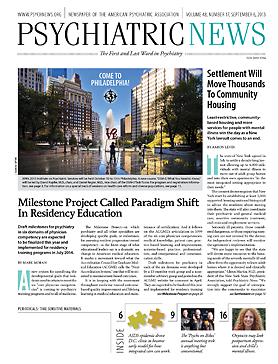De novo mutations—those that occur in individuals spontaneously and are not present in either parent—are more frequent among individuals with schizophrenia than among unaffected siblings, and appear to occur in genes critical to the fetal development of the prefrontal cortex.
That was the finding from a study in the August 1 journal Cell that combines genomics with newly available resources for mapping the function of genes spatially and temporally—that is, where in the brain they function and when in development they become expressed.
The study demonstrates something that has long been hypothesized—that schizophrenia genes operate in pathways important for brain development and that disruptions of fetal prefrontal cortical neurogenesis are critical to the disorder.
“By linking genomic findings to functional measures, this approach gives us additional insight into how early development differs in the brain of someone who will eventually manifest the symptoms of psychosis,” NIMH Director Thomas Insel, M.D., said in a statement.
In an interview with Psychiatric News, senior author Jon McClellan, M.D., of the Department of Psychiatry at the University of Washington, said that the goals of the study were twofold—to determine if de novo mutations play a role in schizophrenia and then to determine whether the genes that carry damaging mutations occur in critical pathways.
He and his colleagues tested 105 patients with schizophrenia who had no family history of the disease and would therefore be most likely to carry de novo mutations, their parents, and one healthy sibling (n=84). They looked for mutations that occurred in either the patient or the healthy sibling but not in the parent.
“Our first finding was that patients with schizophrenia had more of these damaging de novo mutations than their siblings,” McClellan told Psychiatric News. “That by itself is important because it indicates that these spontaneous mutations have a role in some cases of schizophrenia.”
Moreover, almost all of the mutations occurred in different genes; a total of 54 different genes were found to carry a damaging de novo mutation in patients. Only one gene, CACNA1I, was disrupted in more than one affected person; two patients each had a different de novo event in this gene. This further supports the genetic heterogeneity of schizophrenia and suggests that a number of different rare genetic causes can lead to the common clinical presentation.
The researchers then mapped those genes using a newly available Transcriptional Atlas of Human Brain Development—a project supported by NIMH—to determine whether they shared a common functional pathway.
“We found these genes formed a network in the development of the fetal prefrontal cortex,” McClellan said. “It makes perfect sense that these de novo mutations would appear in genes that are significantly enriched at that point in fetal development. Fifty of the 54 genes were critical to basic brain development and neuronal migration.”
He said the findings provide definitive evidence for the long-established “neurodevelopmental theory” of schizophrenia. “It fits with known characteristics of the illness, because it’s common among people with the illness to have problems long before they become psychotic.”
And some of the genes are associated with neurotransmission, indicating targets for more specific treatments.
McClellan also said the importance of de novo mutations, and the disparate genes in which they occur, is in keeping with the heterogeneity of patient presentations. “When it seems as though your patients with schizophrenia are all individuals and different, it’s because they are,” he said. ■
